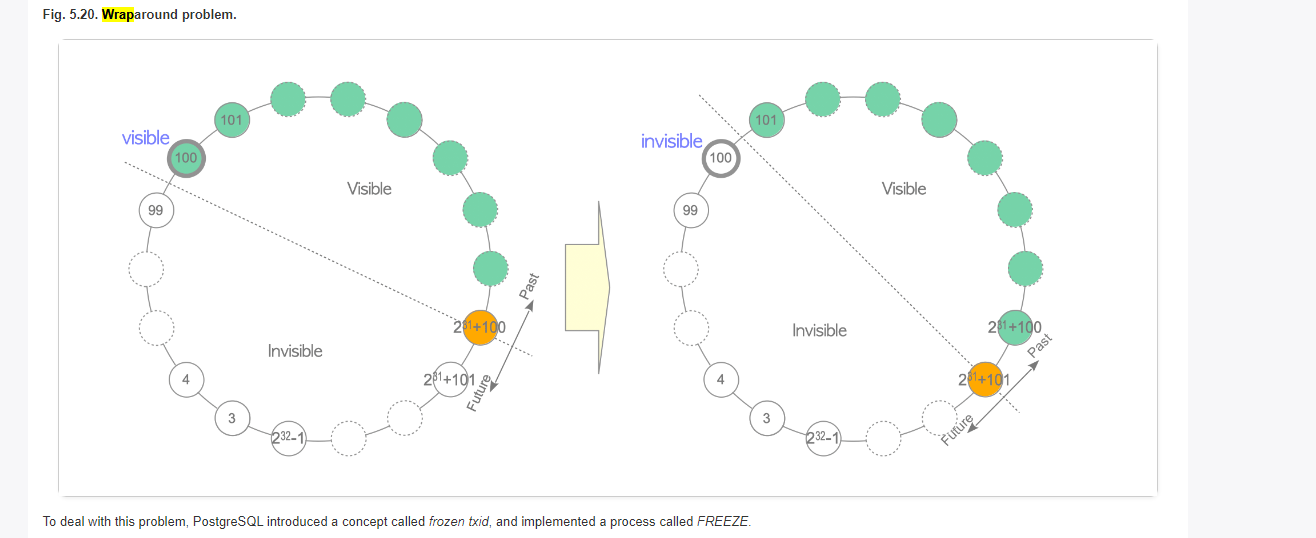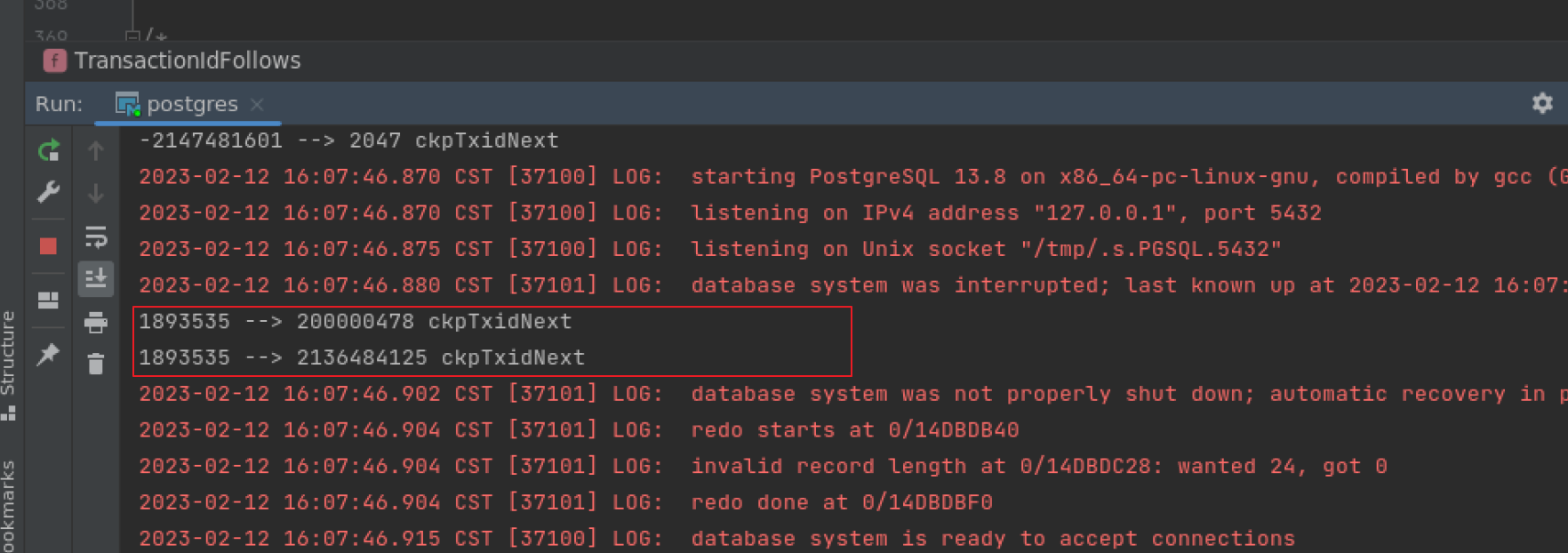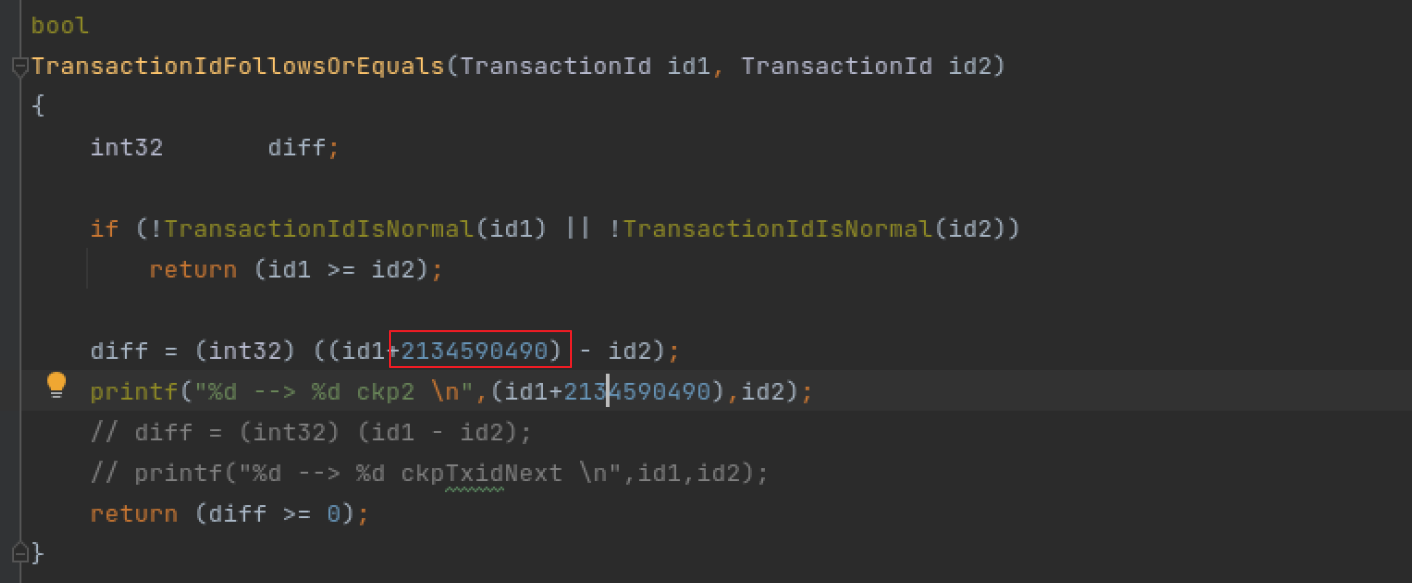
大家好,最近和单位同事聊了聊 PG的MVCC 机制,顺便记录了下来一些内容主要围绕PG事务ID的 transaction wraparound 问题 。
熟悉PG的朋友们都知道 PG 的MVCC 的实现与 MYSQL, ORACLE的undo 机制不同, PG在数据页上直接插入数据,类似于 insert append 直接追加数据, 当数据读取的时候(这里说的隔离级别为read-committed), 通过当前连接的session 的 txid 与 数据页中的 t_xmin,t_xmax 来判断比对从而得出可见的数据。
我们这里暂时不讨论具体的数据可见性的比对规则。 我们要聊的是 PG全局的事务ID :txid
这个值可以通过函数 txid_current() 得到
postgres@[local:/tmp]:1992=#45175 SELECT txid_current();
txid_current
--------------
5303884
(1 row)
复制TXID 这个数值当初设计的时候是一个 无符号的 INT 32 位的数字, 大约的数值范围在42亿左右。这个数值的范围很容易用满,所以在PG采用 cycle 的循环利用的方式来重置 TXID.
由于transaction id 是正整数,所以只有无符号32位整型数字的一半,大致20亿左右。
举个例子,我们借用JP 业界知名大神的著作中的一张图来描述一下 transaction wraparound 问题。
有1个表 t1 写入一条记录 tuple1 的时候是 txid = 100 , PG数据库没有自动或者手动的 vacumm freeze, 或者是这条insert 语句的一直没有提交,
这个系统如果很忙, TPS > 500K/s , 我们假设能达到每秒5W笔的事务, 消耗20亿transaction id 的容量范围的话, 大致需要 11 个小时 (2000000000/50000/3600=11+ hours)
这个时候 再次像表t1 中插入一条新的数据 tuple2 , 这个时候 假设 transaction ID 会重置成 20, 那么就会出现 过去的元祖 tuple1 的 txid = 100 大于 现在或者未来的元祖 tuple2 的 txid = 20的现象,从而造成了多版本MVCC的可见性的混乱的问题。
为了避免这个 transaction wraparound的问题:
PG 采用 freeze 过时的 txid 的方式来实现 , 这个会发生在执行命令 vacuum 的时候.会自动根据参数设置来判断是否只能 txid freeze 的操作。 如果长时间存在未提交的transacction, 或者存在废弃的replicate slot, 那么将不会触发 freeze . 这个数据库会进入到 read-only 的模式下面

FREEZE 的大致是分为2个版本 (图依然来自JP的业界大神)
1.版本9.3之前的版本是直接更新 元祖 head 中的隐藏列的值 t_xmin , 更新为 2。 这样 设置t_xmin =2 对于 所有的transaction 来说都是可见的。

2.对于版本 9.4开始, 会更新位图 t_infomask 标记 为 HEAP_XMIN_FROZEN

关于更新 t_infomask 标记 为 HEAP_XMIN_FROZEN 的信息, 网上的资料很少,目前只能从源代码查看这个位图的定义:
我们查看源码文件 src/include/access/htup_details.h 中的 HEAP_XMIN_FROZEN 的定义: HEAP_XMIN_COMMITTED|HEAP_XMIN_INVALID
HEAP_XMIN_COMMITTED 0x0100 -》 t_infomask & 256
HEAP_XMIN_INVALID 0x0200 -》 t_infomask & 512
HEAP_XMIN_FROZEN 的值取决 HEAP_XMIN_COMMITTED和HEAP_XMIN_INVALID 做或运算, 其中有一个为真,这个元祖即为冻结状态
#define HEAP_XMIN_COMMITTED 0x0100 /* t_xmin committed */
#define HEAP_XMIN_INVALID 0x0200 /* t_xmin invalid/aborted */
#define HEAP_XMIN_FROZEN (HEAP_XMIN_COMMITTED|HEAP_XMIN_INVALID)
复制我们测试一下 vacuum freeze 的执行过程的前后,HEAP_XMIN_FROZEN的值的改变情况,
为了到达测试效果,我们暂时先关闭 auto vacuum 这个参数
postgres@[local:/tmp]:1992=#92720 alter system set autovacuum =off;
ALTER SYSTEM
复制这个参数需要重启数据库:
/opt/postgreSQL/pg15/bin/pg_ctl restart -D /data/postgreSQL/1992/backups
postgres@[local:/tmp]:1992=#102177 show autovacuum;
autovacuum
------------
off
(1 row)
复制我们来创建一张表tab1,插入20条数据: transaction id = 5303898
postgres@[local:/tmp]:1992=#102177 create table tab1 (id int, name varchar(200));
CREATE TABLE
postgres@[local:/tmp]:1992=#102177 begin;
BEGIN
postgres@[local:/tmp]:1992=#27290 select txid_current();
txid_current
--------------
5303898
(1 row)
postgres@[local:/tmp]:1992=#102177 insert into tab1 select generate_series(1,20),'jason';
INSERT 0 20
postgres@[local:/tmp]:1992=#102177 commit;
COMMIT
复制我们用extension pageinpect 来查看一下每条记录关于 transaction id 的 隐藏信息:
我们可以看到 txid = 5303898 这2条记录, 隐藏列 t_infomask 中的 heap_xmin_committed 为 False, heap_xmin_invalid 为False ,
所以我们想要查看的 t_infomask 中的 HEAP_XMIN_FROZEN 是 heap_xmin_committed | heap_xmin_invalid , 也是 False 的
postgres@[local:/tmp]:1992=#27290 SELECT lp,
postgres-# t_ctid AS ctid,
postgres-# t_xmin AS xmin,
postgres-# t_xmax AS xmax,
postgres-# (t_infomask & 256)::boolean AS HEAP_XMIN_COMMITTED,
postgres-# (t_infomask & 512)::boolean AS HEAP_XMIN_INVALID,
postgres-# ((t_infomask & 256)::boolean or (t_infomask & 512)::boolean)::boolean AS HEAP_XMIN_FROZEN
postgres-# FROM heap_page_item_attrs(
postgres(# get_raw_page('tab1', 0),
postgres(# 'tab1'
postgres(# );
lp | ctid | xmin | xmax | heap_xmin_committed | heap_xmin_invalid | heap_xmin_frozen
----+--------+---------+------+---------------------+-------------------+------------------
1 | (0,1) | 5303898 | 0 | f | f | f
2 | (0,2) | 5303898 | 0 | f | f | f
3 | (0,3) | 5303898 | 0 | f | f | f
4 | (0,4) | 5303898 | 0 | f | f | f
5 | (0,5) | 5303898 | 0 | f | f | f
6 | (0,6) | 5303898 | 0 | f | f | f
7 | (0,7) | 5303898 | 0 | f | f | f
8 | (0,8) | 5303898 | 0 | f | f | f
9 | (0,9) | 5303898 | 0 | f | f | f
10 | (0,10) | 5303898 | 0 | f | f | f
11 | (0,11) | 5303898 | 0 | f | f | f
12 | (0,12) | 5303898 | 0 | f | f | f
13 | (0,13) | 5303898 | 0 | f | f | f
14 | (0,14) | 5303898 | 0 | f | f | f
15 | (0,15) | 5303898 | 0 | f | f | f
16 | (0,16) | 5303898 | 0 | f | f | f
17 | (0,17) | 5303898 | 0 | f | f | f
18 | (0,18) | 5303898 | 0 | f | f | f
19 | (0,19) | 5303898 | 0 | f | f | f
20 | (0,20) | 5303898 | 0 | f | f | f
(20 rows)
复制接下来,我们手动执行命令 autovacuum freeze 一下 table tab1:
postgres@[local:/tmp]:1992=#27290 vacuum FREEZE tab1;
VACUUM
复制我们再次查看元祖隐藏列t_infomask中 的 heap_xmin_committed,heap_xmin_invalid和HEAP_XMIN_FROZEN 的值:
我们可以看到 heap_xmin_committed,heap_xmin_invalid和HEAP_XMIN_FROZEN 的值 均变成了 true.
postgres@[local:/tmp]:1992=#27290 SELECT lp,
postgres-# t_ctid AS ctid,
postgres-# t_xmin AS xmin,
postgres-# t_xmax AS xmax,
postgres-# (t_infomask & 256)::boolean AS HEAP_XMIN_COMMITTED,
postgres-# (t_infomask & 512)::boolean AS HEAP_XMIN_INVALID,
postgres-# ((t_infomask & 256)::boolean or (t_infomask & 512)::boolean)::boolean AS HEAP_XMIN_FROZEN
postgres-# FROM heap_page_item_attrs(
postgres(# get_raw_page('tab1', 0),
postgres(# 'tab1'
postgres(# );
lp | ctid | xmin | xmax | heap_xmin_committed | heap_xmin_invalid | heap_xmin_frozen
----+--------+---------+------+---------------------+-------------------+------------------
1 | (0,1) | 5303898 | 0 | t | t | t
2 | (0,2) | 5303898 | 0 | t | t | t
3 | (0,3) | 5303898 | 0 | t | t | t
4 | (0,4) | 5303898 | 0 | t | t | t
5 | (0,5) | 5303898 | 0 | t | t | t
6 | (0,6) | 5303898 | 0 | t | t | t
7 | (0,7) | 5303898 | 0 | t | t | t
8 | (0,8) | 5303898 | 0 | t | t | t
9 | (0,9) | 5303898 | 0 | t | t | t
10 | (0,10) | 5303898 | 0 | t | t | t
11 | (0,11) | 5303898 | 0 | t | t | t
12 | (0,12) | 5303898 | 0 | t | t | t
13 | (0,13) | 5303898 | 0 | t | t | t
14 | (0,14) | 5303898 | 0 | t | t | t
15 | (0,15) | 5303898 | 0 | t | t | t
16 | (0,16) | 5303898 | 0 | t | t | t
17 | (0,17) | 5303898 | 0 | t | t | t
18 | (0,18) | 5303898 | 0 | t | t | t
19 | (0,19) | 5303898 | 0 | t | t | t
20 | (0,20) | 5303898 | 0 | t | t | t
(20 rows)
复制接下来,我们需要在做一个实验, 看看能不能复现PG的 transaction wrapround 的场景:
正如我们理解的 transaction 的一圈长度为 2147483647 , 理论上,如果存在一笔事务长时间不提交或者rollback, session 一直驻留在数据库,
而其他的事务在频繁的操作数据库,类似于OLTP的高负载的情况下, 例如 tps = 5W, 大致需要11个小时就可以复现这个情况。
我们如果没有模拟TPS=5W 这么高并发的机器,而且不想等 10多个小时的话,我们可以尝试修改一段源代码, 大致修改的逻辑就是在下次拿到 TXID的时候,
比较 当前ID和下一个ID的时候, 设置一个基础值,这样就很容易使下一个 txid 达到上限。
我们找到源码文件:src/backend/access/transam/transam.c
/*
* TransactionIdFollowsOrEquals --- is id1 logically >= id2?
*/
bool
TransactionIdFollowsOrEquals(TransactionId id1, TransactionId id2)
{
int32 diff;
if (!TransactionIdIsNormal(id1) || !TransactionIdIsNormal(id2))
return (id1 >= id2);
diff = (int32) (id1 - id2);
return (diff >= 0);
}
复制我们先尝试把id1 和 id2的值打印出来: printf("%d --> %d ckpTxidNext \n",id1,id2);
bool
TransactionIdFollowsOrEquals(TransactionId id1, TransactionId id2)
{
int32 diff;
if (!TransactionIdIsNormal(id1) || !TransactionIdIsNormal(id2))
return (id1 >= id2);
diff = (int32) (id1 - id2);
printf("%d --> %d ckpTxidNext \n",id1,id2);
return (diff >= 0);
}
复制Build 一下项目,重新启动postgres 实例, 其实上PG启动的时候就会进行 next txid 的检查

我们尝试登录数据库,产生一个txid: 这个时候我们发现 PG启动时候 检验了 next txid 和 xidVacLimit 的比较
postgres=# begin;
BEGIN
postgres=*# select txid_current();
txid_current
--------------
1893535
(1 row)
复制
1893536 是我们下一个 txid 的值, 200000478 这个值是 xidVacLimit ,
如果下一个 txid > xidVacLimit 的值的话,PG会在后台强制启动 autovacuum 的进程
TransactionId xidVacLimit; /* start forcing autovacuums here */
复制比较xidVacLimit, 并启动auto vacuum 进程: SendPostmasterSignal(PMSIGNAL_START_AUTOVAC_LAUNCHER);
if (TransactionIdFollowsOrEquals(xid, ShmemVariableCache->xidVacLimit))
{
/*
* For safety's sake, we release XidGenLock while sending signals,
* warnings, etc. This is not so much because we care about
* preserving concurrency in this situation, as to avoid any
* possibility of deadlock while doing get_database_name(). First,
* copy all the shared values we'll need in this path.
*/
TransactionId xidWarnLimit = ShmemVariableCache->xidWarnLimit;
TransactionId xidStopLimit = ShmemVariableCache->xidStopLimit;
TransactionId xidWrapLimit = ShmemVariableCache->xidWrapLimit;
Oid oldest_datoid = ShmemVariableCache->oldestXidDB;
LWLockRelease(XidGenLock);
/*
* To avoid swamping the postmaster with signals, we issue the autovac
* request only once per 64K transaction starts. This still gives
* plenty of chances before we get into real trouble.
*/
if (IsUnderPostmaster && (xid % 65536) == 0)
SendPostmasterSignal(PMSIGNAL_START_AUTOVAC_LAUNCHER);
复制这个值的取值逻辑是 :
xidVacLimit = oldest_datfrozenxid(478) + autovacuum_freeze_max_age (200000000);
我们可以通过执行SQL来验证: 1893535
postgres=# show autovacuum_freeze_max_age;
autovacuum_freeze_max_age
---------------------------
200000000
(1 row)
postgres=# SELECT datname, datfrozenxid, age(datfrozenxid)
postgres-# FROM pg_database;
datname | datfrozenxid | age
-----------+--------------+---------
postgres | 478 | 1893058
template1 | 478 | 1893058
template0 | 478 | 1893058
(3 rows)
复制okay. 我们接下来看看启动的时候,第二个检查点的比较:
这个是 next txid 与 xidStopLimit 比较

关于xidStopLimit 这个值,可以粗线条的理解为 (int32 整型上限的数据 20亿左右 + oldest_datfrozenxid)- 1000000(1百万为 vacuum 操作预留的 txid ):
xidStopLimit 细节的可以参考代码:
计算公式为: xidStopLimit = (oldest_datfrozenxid + (MaxTransactionId >> 1);) - 1000000
= 478 + 2147483647 - 1000000
= 2146484125
/*
* The place where we actually get into deep trouble is halfway around
* from the oldest potentially-existing XID. (This calculation is
* probably off by one or two counts, because the special XIDs reduce the
* size of the loop a little bit. But we throw in plenty of slop below,
* so it doesn't matter.)
*/
xidWrapLimit = oldest_datfrozenxid + (MaxTransactionId >> 1);
if (xidWrapLimit < FirstNormalTransactionId)
xidWrapLimit += FirstNormalTransactionId;
/*
* We'll refuse to continue assigning XIDs in interactive mode once we get
* within 1M transactions of data loss. This leaves lots of room for the
* DBA to fool around fixing things in a standalone backend, while not
* being significant compared to total XID space. (Note that since
* vacuuming requires one transaction per table cleaned, we had better be
* sure there's lots of XIDs left...)
*/
xidStopLimit = xidWrapLimit - 1000000;
if (xidStopLimit < FirstNormalTransactionId)
xidStopLimit -= FirstNormalTransactionId;
复制如果next txid的值,大于了 xidStopLimit 这个极限值,那么数据库变成不可用的状态。 也就是说数据库为了避免发生 transaction wraparound, 将整个数据库变成了只读的状态。
我们来修改源代码模拟一下: src/backend/access/transam/transam.c
比较的时候添加一个基础值为 2134590490 = 2136484125(xidStopLimit) - 1893535(TXID) - 100(这个100是预留给我们做实验用的)
这个基础值的作用是 类似于提前替我们消耗了 2134590490 多个 txid, 我们只需自己写满预留的100个就可以 复现数据库为了防止 transaction wrapround 进行的报错。

重新编译启动项目: 这次我们可以看到 2136484125 - 2136484027 = 98 个可用的ID
PG刚才关闭和启动各自消耗了一个TXID, 所以还剩98个可以让我们自己消耗掉

我们只需要手动的耗费98个ID即可:
我们打开2个窗口:
session1: 模拟一个不提交的空session
session2: 用PGPLSQL loop一个 消耗99 条事务的循环
session1:模拟一个不提交事务的空session
postgres=# begin;
BEGIN
postgres=*# select txid_current();
txid_current
--------------
1893537
(1 row)
复制session 2: PGPLSQL loop一个 消耗99 条事务的循环
我们成功的模拟出数据库错误:
WARNING: database “postgres” must be vacuumed within 2145590490 transactions
HINT: To avoid a database shutdown, execute a database-wide VACUUM in that database.
You might also need to commit or roll back old prepared transactions, or drop stale replication slots.
postgres=# DO
postgres-# $$
postgres$# DECLARE
postgres$# i INTEGER := 1;
postgres$# BEGIN
postgres$# FOR i IN 1..98 LOOP
postgres$# begin
postgres$#
postgres$# insert into t1 values (i);
postgres$#
postgres$# commit;
postgres$#
postgres$# end;
postgres$# END LOOP;
postgres$# END;
postgres$# $$ language plpgsql;
WARNING: database "postgres" must be vacuumed within 2145590490 transactions
HINT: To avoid a database shutdown, execute a database-wide VACUUM in that database.
You might also need to commit or roll back old prepared transactions, or drop stale replication slots.
复制
如何解决: 其实错误日志已经告诉了我们:
1.找出问题根源,是否存在提交或者回滚的事务, 我们可以用检查事务打开的语句:
select locktype,
relation::regclass as rel,
virtualxid as vxid,
transactionid as xid ,
virtualtransaction as vxid2,
pid,
mode,
granted
from pg_locks;
locktype | rel | vxid | xid | vxid2 | pid | mode | granted
---------------+----------+-------+---------+-------+-------+-----------------+---------
relation | pg_locks | | | 4/104 | 45976 | AccessShareLock | t
virtualxid | | 4/104 | | 4/104 | 45976 | ExclusiveLock | t
virtualxid | | 3/8 | | 3/8 | 45763 | ExclusiveLock | t
transactionid | | | 1893537 | 3/8 | 45763 | ExclusiveLock | t
(4 rows)
复制需要手动kill 掉这个 xid = 1893537的后台进程45763 , (生产环境需要和你们的开发人员和客户确认)
postgres=# select pg_terminate_backend(45763);
pg_terminate_backend
----------------------
t
(1 row)
复制2.手动 vacuum freeze
postgres=# vacuum freeze;
VACUUM
复制写到最后,
1)其实关于PG TXID 的问题已经在社区内讨论了很久, 已经很多次提议升级扩展到到int 64bit:
Add 64-bit XIDs into PostgreSQL 16 - Commitfests https://commitfest.postgresql.org/38/3594/
这个是最新的建议加到PG16中, 当然了之前也有建议加入到PG15版本中的讨论。 目前尚无考证会修改这个问题。
2)对于数据库和表的年龄要做好监控,以及表上最后的vacuum, analyze 的时间
3)需要数据库中监控长事务和不(提交|回滚)的短事务,无论是active 的session 跑的大的report的,还是应用开发的代码的有bug,造成的短小事务忘记提交。
可以设置参数 idle_in_transaction_session_timeout (默认是0是不限制超时)来强制kill掉 idle_in_transaction 的session , 此类型的session 多为应用开发代码的bug造成的
4)如果standby 退役了,存在相关的replicate slot 要及时删掉
5) 超级大表,可以考虑进行分区,充分利用parallel vacuum来加快大表 freeze, analyze 的速度
6)根据数据库业务负载的情况,定期(比如每周一次,每天夜里某个时刻) 在low business hour的时候,手动进行 vacumm 的操作。
Have a fun 😃 !






